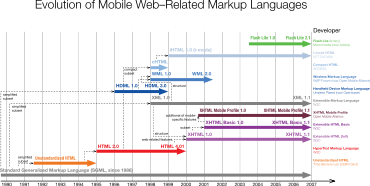C-HTML

| HTML |
|---|
| Comparisons |
C-HTML (short for Compact HyperText Markup Language), also called i-mode-HTML,[1] is a subset of HTML for small information devices, such as first-generation smart phones and PDAs, such as DoCoMo's i-mode mobile phones used in Japan. C-HTML adds several features not found in standard HTML, notably accesskeys, phone number shortcuts for links, and emoji pictorial characters as locally extended Shift JIS, all concepts borrowed from HDML and WML.
Because small devices such as cellular phones have hardware restrictions such as lower memory, low-power CPUs with limited or no storage capabilities, small monochrome display screens, single-character fonts and restricted input methods (the absence of a keyboard or a mouse), there is a need for a simpler form of HTML.[2]
C-HTML does not support tables, image maps, multiple fonts and styling of fonts, background colors and images, frames, or style sheets, and is limited to a monochromatic display.[3]
The language is defined so that all the basic interactive operations can be done by a combination of four buttons and not by two-dimensional cursor movement: cursor forward, cursor backward, select, and back/stop. Functionality requiring two-dimensional cursor pointing, like image maps, is excluded from C-HTML.
See also
- Comparison of document markup languages
- Information appliance
- List of document markup languages
- Microbrowser
References
- ↑ i-mode service guideline (PDF), NTT DoCoMo, Inc., 2002-03-04
- ↑ Kamada, Tomihisa (9 Feb 1998), 2.1. Scope of the Products, W3C, retrieved 2009-04-24
- ↑ Kamada, Tomihisa (9 Feb 1998), 3.1 Design Principles, W3C, retrieved 2009-04-24